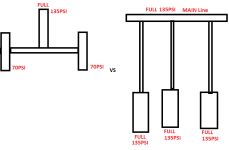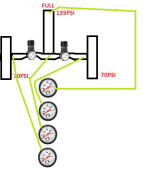Skiroy
Member
The problem is my employer has a Main line coming off the 3" Airline Pipe. It goes from the pipe through a 1.5" hose into a 3/4" T fittings where it splits and goes to 2 seperate Air Regulators which eac h go to a seperate Air Horn. The Main Line Pressure is abou 120-135PSI.
The problem is these things are only getting 60-70PSI turn all the way up and they are not sucking out the Boric Acid properly.
I am guessing its because its split at the regulators. If Its split at where it comes off the main 3" pipe or if I beefed up the 3/4" to 1.5" where it splits can I get an increase of pressure?
The regulators are obviously splitting the Pressure. They each get 65PSI when the Main is 135PSI ish. Even though they are Split with a T pipe fitting, I dont get this. It does make logical sense but each station also has a seperate Regulator coming from the main 3" Air Pipe. Technically this is splitting the Air off the Main Line, just on a bigger scale, so why can these regulator get up to the full main pressure instead od the Pressure being divided by the number of regulators? Is it jus how clost the splits take place at? I included a crude pic to illustrate what Im asking.

The problem is these things are only getting 60-70PSI turn all the way up and they are not sucking out the Boric Acid properly.
I am guessing its because its split at the regulators. If Its split at where it comes off the main 3" pipe or if I beefed up the 3/4" to 1.5" where it splits can I get an increase of pressure?
The regulators are obviously splitting the Pressure. They each get 65PSI when the Main is 135PSI ish. Even though they are Split with a T pipe fitting, I dont get this. It does make logical sense but each station also has a seperate Regulator coming from the main 3" Air Pipe. Technically this is splitting the Air off the Main Line, just on a bigger scale, so why can these regulator get up to the full main pressure instead od the Pressure being divided by the number of regulators? Is it jus how clost the splits take place at? I included a crude pic to illustrate what Im asking.







